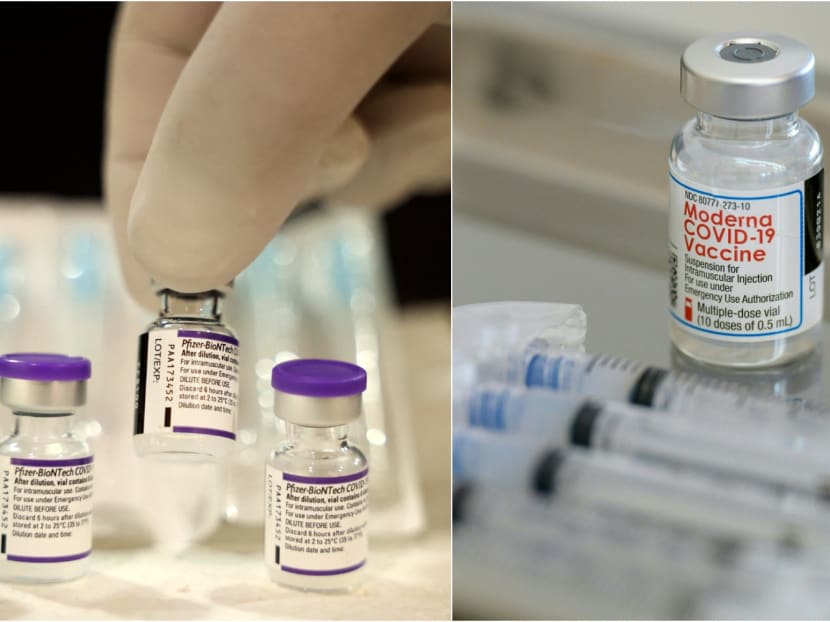Explainer: What’s the best mix of Covid-19 vaccines and boosters? Early indications and studies may shed some light
SINGAPORE — Choices, choices and so many considerations. For people in Singapore, it seems that picking their Covid-19 vaccine booster is not a straightforward affair and for some, it has been a shot in the dark.

More often than not, the mixing of different vaccines to protect against the same disease is borne out of necessity rather than preference, such as if one vaccine is in short supply.
- Studies have shown that switching to a different vaccine as a booster may help the immune system work better, but not always
- People who have taken two doses of the Pfizer-BioNTech vaccine will get more protection with a Moderna booster than with another Pfizer shot
- Yet, not much is known about people who got two doses of Moderna in Singapore’s experience
- One study in the US suggested that Moderna boosters trigger a stronger antibody response
- Another report from Chile suggested that for someone who took two doses of Sinovac vaccine, a Pfizer-BioNTech booster works well
SINGAPORE — Choices, choices and so many considerations. For people in Singapore, it seems that picking their Covid-19 vaccine booster is not a straightforward affair and for some, it has been a shot in the dark.
They get a notification by phone from the Ministry of Health (MOH) inviting them to get the jab and they wonder which to take. Two main choices are available for most people: The messenger ribonucleic acid (mRNA) vaccines from Pfizer-BioNTech and Moderna. And in limited cases, the Sinovac and Sinopharm vaccines.
In July, the World Health Organization (WHO) warned the world against the “dangerous trend” of people deciding to mix and match vaccines and boosters on their own, and called on governments and public health agencies to make recommendations based on public health data.
“We are in a data-free, evidence-free zone as far as mix and match,” its chief scientist Soumya Swaminathan said.
The first data on vaccine mixing came out from some countries that were forced to suspend their Oxford-AstraZeneca vaccine roll-out due to blood clots. Studies found that taking other vaccines for subsequent doses may grant greater protection against the coronavirus.
However, for countries such as Singapore that have not seen the use of the AstraZeneca vaccine, the science behind intentionally mismatching vaccine doses — known as a heterologous prime-boost vaccination — has been progressing slowly over the past four months.
On Monday (Nov 15), Health Minister Ong Ye Kung said MOH found that for people who have taken two doses of the Pfizer-BioNTech vaccine, a Moderna booster dose can reduce the risk of infection more effectively than another dose of Pfizer.
No information was available from the MOH study on people who took the Moderna vaccine for their first two shots, since the sample is too small to be significant.
Sinovac, an inactivated virus vaccine that later came to be part of Singapore’s national vaccination programme, is not recommended as a booster, unless the individual has allergies or is medically ineligible for mRNA vaccines.
Here is what you need to know about mixing and matching boosters.
WHY DOES VACCINE MIXING AND MATCHING WORK?
More often than not, the mixing of different vaccines to protect against the same disease is borne out of necessity rather than preference, such as if one vaccine is in short supply.
Some of the most common vaccines used in humans are the smallpox vaccine for its namesake virus, Bacille Calmette Guerin for tuberculosis, the measles vaccine, the oral polio vaccine and DTP vaccine (for diphtheria, tetanus and pertussis).
The heterologous relationship of these vaccinations has long been studied to see how they interact, though how they contribute to immunity is not yet fully understood.
For example, several studies have shown how female mortality increases among those who had been vaccinated with the BCG and later got the DTP jab.
Professor Antonio Bertoletti at the Duke-NUS Medical School noted that vaccines can also have positive effects, such as in the case of the Ebola vaccine.
“In the past, for HIV (human immunodeficiency virus) or hepatitis B vaccines, it has been already seen that mixing two different vaccines was better in terms of immunogenicity,” he said.
Simply put, different vaccine types are designed to encourage the development of antibodies against Sars-CoV-2 differently.
Dr Asok Kurup, who chairs the Academy of Medicine's Chapter of Infectious Disease Physicians, said: “So rather than from one particular way, a heterologous vaccination means you are stimulating (the immune system) in different ways so that you get a more diverse mix of immune cells. At least that is in theory.”

WHAT DOES THE SCIENCE SAY?
A vaccine booster is any extra dose of a vaccine that is given to maintain or augment the protection provided by the original dose or doses. This is because vaccines may confer less protection over time.
The third dose restores the person’s protection against Covid-19. It is determined by a wide range of factors that humanity is still trying to understand. This includes, but is not restricted to, the antibody response after vaccination.
In October, the United States’ National Institutes of Health released a preliminary report looking at the effectiveness of various combinations of boosters for people who received the full regimen of vaccines approved for use in the US: Pfizer-BioNTech, Moderna and Johnson & Johnson (J&J).
Authored by 37 doctors and academics, the pre-print report studied the antibody levels of 458 volunteers two and four weeks after the booster jab. A pre-print means that the study has not been peer-reviewed.
It found that using vaccines interchangeably can be a good thing, especially for those who received the J&J vaccine. And those who had two doses of the Moderna or Pfizer-BioNTech vaccines had better antibody responses at the two-week mark after a Moderna booster than a Pfizer one.
However, the researchers noted that their study was limited — its sample size was too small for a representative finding. They also said that it was not designed to identify which booster, or which combination of vaccines, is superior.
The people in the study had also received a 100mcg dose of Moderna as a booster, instead of the 50mcg dose that both the US and Singapore administer for booster shots.
Associate Professor Hsu Li Yang, vice-dean of global health and programme leader of infectious diseases at the Saw Swee Hock School of Public Health, said that it is also not clear how any of these findings translates to protection from Covid-19 and the duration of immune response.
“One caution is that better data is needed before a general recommendation to mix and match different vaccines, that X followed by Y elicits a strong protective effect does not necessarily mean that Y followed by X will result in the same,” he added.
Dr Kurup said: “Nobody in this universe at the moment knows which particular immune correlate best defines protection.
“It’s all nice to know which (vaccine combination) produces what antibody level, but at the end of the day, how good is it in helping prevent disease or critical infection?”
An immune correlate of protection is the level of antibodies needed to prevent a disease. A defined correlate will help inform decisions on the use of approved vaccines and determine the potential mechanisms of protection, for instance.
WHAT ABOUT SINOVAC?
As for Sinovac, not much reliable information is available on whether the vaccine’s recipients should take a different dose, though a presentation to the WHO by the Chilean government last month showed higher effectiveness against Covid-19 when taking a Pfizer shot as a third dose.
Assoc Prof Hsu said that not much is also known about heterologous boosting using the Sinopharm, another inactivated virus vaccine.
Singapore is strongly recommending either the Pfizer-BioNTech or Moderna vaccines as a third dose for Sinopharm recipients, and for Sinopharm to be given at three months after the second dose if they decline the mRNA vaccines.
China, which produces both Sinopharm and Sinovac vaccines, has been evaluating whether to adopt a vaccine-mixing strategy.
On Monday, its officials announced that it would allow boosting with other vaccines soon, including with vaccines of different technologies, making it possible for an mRNA vaccine jointly developed by Germany’s BioNTech and China’s Fosun Pharma to be approved.
Prof Bertoletti of Duke-NUS Medical School said that it is still an unproven hypothesis for inactivated virus vaccines such as Sinopharm and Sinovac to be administered as a booster after two doses of mRNA vaccines, but it may be a good idea, too.
“The inactivated vaccine does not carry only spike proteins, like mRNA vaccines, but also other viral proteins like nucleoprotein and the membrane. These proteins may elicit a broad immunity… which can potentially be more protective,” he added.
IS MIXING VACCINES SAFE?
The US study concluded that there were no safety concerns identified in mixing vaccines, echoing early research on heterologous first and second jabs.
A vaccine safety workgroup under the US Centers for Disease Control and Prevention also concluded in an October presentation that using a different vaccine for a booster poses no additional safety risk on top of the current risks from each vaccine itself.
Assoc Prof Hsu said that there may be more “reactogenic” side effects though. These are the side effects of fatigue, arm pain or fever, which may be somewhat worse with mixing vaccines.
As of Oct 31, there were a total of 200 reports of suspected adverse events, or unfavourable medical conditions, experienced by people who received Covid-19 vaccine boosters, the Health Sciences Authority said on Tuesday.
This is out of a total of 854,268 booster shots administered since the national Covid-19 booster vaccination programme was rolled out on Sept 15, and represents just 0.02 per cent of booster shots administered.
Adverse events for boosters were largely similar to those reported for the first two doses of the mRNA vaccines, the authority said.
WHY NOT MANDATE THE BEST COMBINATION?
Like most other governments, Singapore is not mandating which vaccine options people should take, though Monday’s announcement of the MOH study may sway minds, experts said.
Singapore is also allowing any eligible adults above the age of 30 to receive a Moderna booster without an appointment.
This could encourage the large majority of people who received Pfizer-BioNTech for their two doses — Singapore began its vaccination programme with it after all — to mix their shots.
When asked if governments, rather than individuals, should recommend and restrict people’s choices on boosters, Dr Kurup from the Academy of Medicine said: “I wish there was a bit more clarity (on which combinations are encouraged or discouraged).”
Doing so would clear up the confusion faced by clinicians trying to explain to people the booster options that are available to them, he added.
“But I am not a policy person... and from governments’ perspectives, the science behind vaccine mixing is still evolving. No one wants to be shot in the foot mandating something that ends up being wrong.”











